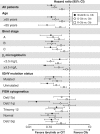Single-agent ibrutinib versus chemoimmunotherapy regimens for treatment-naïve patients with chronic lymphocytic leukemia: A cross-trial comparison of phase 3 studies
- PMID: 30129285
- PMCID: PMC6221114
- DOI: 10.1002/ajh.25259
Single-agent ibrutinib versus chemoimmunotherapy regimens for treatment-naïve patients with chronic lymphocytic leukemia: A cross-trial comparison of phase 3 studies
Abstract
Chemoimmunotherapy (CIT) and targeted therapy with single-agent ibrutinib are both recommended first-line treatments for chronic lymphocytic leukemia (CLL), although their outcomes have not been directly compared. Using ibrutinib data from the RESONATE-2 (PCYC-1115/1116) study conducted in patients ≥65 years without del(17p), we performed a cross-trial comparison with CIT data from published phase 3 studies in first-line treatment of CLL. Progression-free survival (PFS), overall survival (OS), and safety data for ibrutinib (median follow-up 35.7 months) were evaluated alongside available CIT data. CIT regimens included: fludarabine + cyclophosphamide + rituximab (CLL8, CLL10), bendamustine + rituximab (CLL10), obinutuzumab + chlorambucil and rituximab + chlorambucil (CLL11), and ofatumumab + chlorambucil (COMPLEMENT-1). Median age across studies was 61-74 years, with older populations receiving ibrutinib, obinutuzumab + chlorambucil, or rituximab + chlorambucil. Median follow-up varied across studies/regimens (range 14.5-37.4 months). Among all patients, PFS appeared longer with ibrutinib relative to CIT and OS appeared comparable. Relative to CIT studies that similarly excluded patients with del(17p) (CLL10) or enrolled older/less-fit patients (CLL11), PFS appeared favorable for ibrutinib in high-risk subgroups, including advanced disease, bulky lymph nodes, unmutated IGHV status, and presence of del(11q). Grade ≥ 3 infections ranged from 9% (ofatumumab + chlorambucil) to 40% (fludarabine + cyclophosphamide + rituximab), and was 25% with ibrutinib. Grade ≥ 3 neutropenia was 12% for ibrutinib and 26%-84% for CIT. Although definitive conclusions cannot be made due to inherent limitations of cross-trial comparisons, this report suggests that ibrutinib has a favorable benefit/risk profile and may potentially eliminate the need for chemotherapy in some patients. Randomized, comparative studies are needed to support these findings.
© 2018 The Authors. American Journal of Hematology published by Wiley Periodicals, Inc.
Figures


References
-
- Hallek M. Chronic lymphocytic leukemia: 2017 update on diagnosis, risk stratification, and treatment. Am J Hematol. 2017;92(9):946‐965. - PubMed
-
- Eichhorst B, Robak T, Montserrat E, et al. Chronic lymphocytic leukaemia: ESMO clinical practice guidelines for diagnosis, treatment and follow‐up. Ann Oncol. 2015;26(suppl 5):v78‐v84. - PubMed
-
- ESMO Guidelines Committee. eUpdate – chronic lymphocytic leukaemia treatment recommendations 2017; http://www.esmo.org/Guidelines/Haematological-Malignancies/Chronic-Lymph.... Accessed March 30, 2018.
-
- Hallek M, Fischer K, Fingerle‐Rowson G, et al. Addition of rituximab to fludarabine and cyclophosphamide in patients with chronic lymphocytic leukaemia: a randomised, open‐label, phase 3 trial. Lancet. 2010;376(9747):1164‐1174. - PubMed
-
- Fischer K, Bahlo J, Fink AM, et al. Long‐term remissions after FCR chemoimmunotherapy in previously untreated patients with CLL: updated results of the CLL8 trial. Blood. 2016;127(2):208‐215. - PubMed
